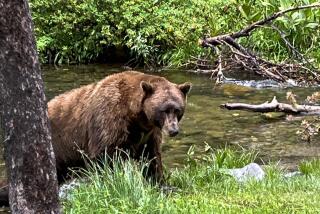Polar bear is listed as threatened species
The Interior Department on Wednesday designated the polar bear as threatened with extinction because of shrinking sea ice, making it the first creature added to the endangered species list primarily because of global warming.
The designation under the Endangered Species Act requires the agency to identify critical habitat to be protected and to form a strategy to assist the bear population’s recovery.
But the department also issued special rules designed to exempt from the law offshore oil and gas drilling in prime polar bear habitat off Alaska’s north coast.
FOR THE RECORD:
Polar bear’s status: Headlines in Thursday’s Section A about an Interior Department ruling said that it was listing the polar bear as an endangered species. The Interior Department actually gave the bear “threatened” status under the Endangered Species Act. An “endangered” species is defined by the act as facing likely extinction in its natural habitat, while a “threatened” species is seen as one that’s likely to fall into the endangered category in the foreseeable future. —
Moreover, Interior Secretary Dirk Kempthorne announced he was taking a series of steps to short-circuit legal plans by conservation groups to use the polar bear’s protected status to block new power plants and other sources of carbon dioxide and other gases that contribute to global warming.
He said listing the polar bear as threatened “should not open the door to use the ESA to regulate greenhouse gas emissions from automobiles, power plants and other sources. That would be a wholly inappropriate use of the Endangered Species Act. The ESA is not the right tool to set U.S. climate policy.”
Dale Hall, director of the Interior Department’s Fish and Wildlife Service, said the law was intended to preserve species and their habitats from localized threats such as filling wetlands, felling trees and development. He cast doubt on whether far-flung conditions, such as emissions from tailpipes, feedlots and smokestacks around the globe, could be directly linked to the shrinking sea ice.
“We have to connect the dots between an action and an impact on a species,” Hall said. “We don’t have the science to do that.”
Conservation groups, however, have been gearing up to test that premise in court.
Kassie Siegel, an attorney with the Center for Biological Diversity, said efforts to limit the reach of the designation and avoid clamping down on greenhouse gas emissions were “illegal and won’t hold up in court.”
A Supreme Court ruling last year that defined carbon dioxide as a pollutant undermines the Interior Department’s position, said Andrew Wetzler, an attorney with the Natural Resources Defense Council. Under Massachusetts vs. EPA, he said, “you don’t need to show that you can solve an entire problem by going after a specific source.”
Opponents of the designation likewise plan to challenge Kempthorne’s decision. The Pacific Legal Foundation, a property rights group, vowed to sue, saying the Interior Department relied on speculative computer models about warming Arctic conditions and vanishing ice.
In announcing his decision, Kempthorne complained about the “inflexibility” of the Endangered Species Act; he said it failed to consider negative economic effects on people or industries. But, he said, he was left with no legal choice.
“You simply must look at the best available science on this species and project it into the future,” Kempthorne said. “I have accepted the science. . . . This may not be a popular decision, but it’s the right decision.”
It was the first time in more than two years that the Interior Department had extended protections to a species under the Endangered Species Act -- the longest hiatus of new listings by the department since President Nixon signed the law in 1973.
It came after a U.S. District Court in Oakland forced Kempthorne’s hand by imposing a May 15 deadline following the Interior Department’s failure to meet the law’s prescribed time schedule. The court order was prompted by conservation groups that sued Kempthorne for missing the law’s deadline.
Meanwhile, members of Congress held hearings to demand why Kempthorne was holding up the polar bear decision while allowing his agency on Feb. 6 to sell leases to new offshore oil and gas fields in the Chukchi Sea off Alaska. At the time, Kempthorne ducked those hearings and questions.
On Wednesday, the Interior secretary said he saw no reason to hold up the offshore leases because Fish and Wildlife Service scientists said the projected decline of the polar bear was due to vanishing sea ice, not oil and gas development.
“For me to hold up the lease sale in the Chukchi Sea would have implied a connection,” Kempthorne said. “There was not.”
In December 2006, Kempthorne announced that there was sufficient scientific evidence of the bear’s melting habitat to propose protecting it under the Endangered Species Act. Since then, the future for the top predator at the top of the world has looked increasingly bleak.
Last summer, Arctic sea ice receded to record levels -- a retreat that about half of the climate modelers did not think would happen until 2050.
In September, scientists at the U.S. Geological Survey released a nine-volume analysis of how a warming Arctic is affecting sea ice and reached a dire forecast: Two-thirds of the polar bear’s habitat would disappear by 2050.
Polar bears are experts at hunting ringed seals and other prey from sea ice. But they are so unsuccessful on land that they spend their summers fasting, losing more than 2 pounds a day.
This forced fast is now about three weeks longer than it was 30 years ago, according to studies in Canada’s western Hudson Bay. This gives the bears less time to hunt and build up the fat reserves they need to survive until ice re-forms in the fall and they can resume hunting.
As bears have become thinner, the reproductive rates of females and survival rates of cubs have declined. Overall, the western Hudson Bay population has dropped by 22% since 1987, according to studies.
These bears in Hudson Bay are among the best studied. Scientists don’t know if similar trends exist elsewhere in the Arctic, a vast and forbidding place to conduct field studies. Surveys have shown other problems, including bears drowning in open waters and cannibalism among hungry bears.
Scientists think the global population of 20,000 to 25,000 bears remains robust, rebounding from the 1960s, when hunting had driven down the population to about 12,000. But virtually all polar bear experts predict rapid population declines in the Arctic, which is warming faster than anywhere else in the world and changing too rapidly for the bears to adapt and find other food sources.
A group of Canadian scientists last month declared the polar bear a “species of concern” but stopped short of saying it was threatened with extinction -- a designation that could have restricted hunting by Canada’s Inuit people.
Canada has about two-thirds of the world’s polar bear population. Kempthorne and Canada’s environmental minister last week signed an agreement with tribal government to consider “the best available scientific information and aboriginal traditional knowledge.”
The Nunavut Wildlife Management Board, which operates in Canada’s far north, recently proposed reducing the quota of polar bears hunted in Baffin Bay. But Inuit trappers and hunters opposed the move, saying their traditional knowledge revealed too many bears in the area.
The new protections under U.S. law will not affect the subsistence hunt in Canada, nor preclude native hunters from selling permits for as much as $30,000 to trophy hunters from the United States.
But it will prohibit trophy hunters from importing polar bear skins or heads into the United States. About 70 such trophies have been brought back each year.
“Native hunters claim they’ll kill these bears anyway,” said Paul Todd of the International Fund for Animal Welfare. “But if they don’t need them for subsistence hunting, then, in reality, fewer bears will be killed each year.”
More to Read
Sign up for Essential California
The most important California stories and recommendations in your inbox every morning.
You may occasionally receive promotional content from the Los Angeles Times.










